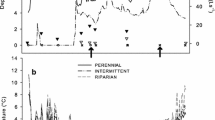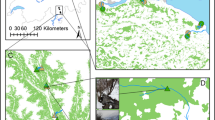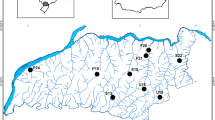Abstract
Interactions between macroconsumers (predators and large omnivores) and detritus breakdown on river floodplains are poorly understood, yet important to ecosystem function. We evaluated the impact of macroconsumers on leaf breakdown, macroinvertebrate abundance and biomass, and fungal biomass on a river floodplain using exclosures in 6 wetlands during a severe drought during which the floodplain was disconnected from the river. Sweetgum (Liquidambar styraciflua) leaves were held in both mesh bags and in leaf packs within each exclosure. After 301 days, breakdown rates (k) were slow and did not significantly differ between treatments. Fungal biomass and total macroinvertebrate abundance and biomass also did not significantly differ between treatments. Collector-gatherers were significantly more abundant in treatments open to macroconsumers in mesh bags. Shredders had significantly higher biomass in packs held in exclosures closed to macroconsumers, but were rare. A subsequent exclosure experiment in one flooded wetland mimicked stream-floodplain connectivity despite drought. Pre-conditioned leaves in mesh bags open to macroconsumers had significantly faster breakdown than those closed to macroconsumers. Abundance of total macroinvertebrates, scrapers and predators were higher in treatments open to macroconsumers. These results indicate that the role of macroconsumers on floodplains varies depending on river connectivity and water availability.




Similar content being viewed by others
References
Batzer DP (2013) The seemingly intractable ecological responses of invertebrates in north American wetlands: a review. Wetlands 33(1):1–15. https://doi.org/10.1007/s13157-012-0360-2
Batzer DP, Wissinger SA (1996) Ecology of insect communities in nontidal wetlands. Annu Rev Entomol 41(1):75–100. https://doi.org/10.1146/annurev.en.41.010196.000451
Batzer DP, Palik BJ, Buech R (2004) Relationships between environmental characteristics and macroinvertebrate communities in seasonal woodland ponds of Minnesota. J N Am Benthol Soc 23(1):50–68. https://doi.org/10.1899/0887-3593
Benfield EF (2007) Decomposition of leaf material. In: Hauer FR, Lamberti GA (eds) Methods in stream ecology, Second edn. Academic Press, San Diego, pp 711–720
Benke AC, Huryn AD, Smock LA, Wallace JB (1999) Length-mass relationships for freshwater macroinvertebrates in North America with particular reference to the southeastern United States. J N Am Benthol Soc 18(3):308–343
Benke AC, Chaubey I, Ward GM, Dunn EL (2000) Flood pulse dynamics of an unregulated river floodplain in the southeastern U.S. coastal plain. Ecology 81(10):2730–2741
Boyero L, Rincon PA, Pearson RG (2008) Effects of a predatory fish on a tropical detritus-based food web. Ecol Res 23(4):649–655
Brady JK, Turner AM (2010) Species-specific effects of gastropods on leaf litter processing in pond mesocosms. Hydrobiologia 651(1):93–100. https://doi.org/10.1007/s10750-010-0267-y
Bright EG, Batzer DP, Garnett JA (2010) Variation in invertebrate and fish communities across floodplain ecotones of the Altamaha and savannah rivers. Wetlands 30(6):1117–1128. https://doi.org/10.1007/s13157-010-0116-9
Butler MJ (1989) Community responses to variable predation: field studies with sunfish and freshwater macroinvertebrates. Ecol Monogr 59(3):311–328
Clarke KR, Gorley RN (2006) PRIMER v6: User Manual/Tutorial. PRIMER-E, Plymouth, 192 pp
Cowardin LM, Carter V, Golet FC, LaRoe ET (1979) Classification of wetlands and deepwater habitats of the United States. U.S. Dept. of the Interior, Fish and Wildlife Service, Washington, D.C.
Cuffney TF, Wallace JB (1987) Leaf litter processing in Coastal Plain streams and foodplains of southeastern Georgia, USA. Archiv für Hydrobiologie Supplementband Monographische Beiträge 76(1–2):1–24
Dorn NJ, Cook MI (2015) Hydrological disturbance diminishes predator control in wetlands. Ecology 96(11):2984–2993. https://doi.org/10.1890/14-1505.1
Dorn NJ, Volin JC (2009) Resistance of crayfish (Procambarus spp.) populations to wetland drying depends on species and substrate. J N Am Benthol Soc 28(4):766–777. https://doi.org/10.1899/08-151.1
Gessner MO, Chauvet E (1993) Ergosterol-to-biomass conversion factors for aquatic hyphomycetes. Appl Environ Microbiol 59(2):502–507
Gessner MO, Chauvet E, Dobson M (1999) A perspective on leaf litter breakdown in streams. Oikos 85(2):377–384
Gessner MO, Swan CM, Dang CK, McKie BG, Bardgett RD, Wall DH, Hättenschwiler S (2010) Diversity meets decomposition. Trends Ecol Evol 25(6):372–380
Greig HS, McIntosh AR (2006) Indirect effects of predatory trout on organic matter processing in detritus-based stream food webs. Oikos 112(1):31–40. https://doi.org/10.1111/j.0030-1299.2006.14219.x
Gulis V, Suberkropp KF (2006) Fungi: biomass, production, and sporulation of aquatic hyphomycetes. In: Hauer FR, Lamberti GA (eds) Methods in stream ecology, Second edn. Academic Press, San Diego, pp 311–325
Hauer FR, Resh VH (2007) Macroinvertebrates. In: Hauer FR, Lamberti GA (eds) Methods in stream ecology, Second edn. Academic Press, San Diego, pp 435–454
Homyack JA, Sucre EB, Haas CA, Fox TR (2010) Does Plethodon cinereus affect leaf litter decomposition and invertebrate abundances in mixed oak forest? J Herpetol 44(3):447–456. https://doi.org/10.1670/09-107.1
IPCC (2014) Climate change 2014: synthesis report. Switzerland, Geneva
Jabiol J, Cornut J, Danger M, Jouffroy M, Elger A, Chauvet E (2014) Litter identity mediates predator impacts on the functioning of an aquatic detritus-based food web. Oecologia 176(1):225–235. https://doi.org/10.1007/s00442-014-2990-y
Junk WJ, Wantzen KM (2004) The flood pulse concept: new aspects, approaches and applications - an update. In: Welcomme R, Petr T (eds) Proceedings of the second international symposium on the management of large rivers for fisheries, FAO regional Office for Asia and the Pacific, vol I. Bangkok, Thailand, pp 117–140
Junk WJ, Bayley PB, Sparks RE (1989) The flood pulse concept in river-floodplain systems. In: Dodge DP (ed) International Large River Symposium, Canadian Special Publications of Fisheries and Aquatic Sciences 106. Department of Fisheries and Oceans, Ottawa, pp 110–127
Konishi M, Nakano S, Iwata T (2001) Trophic cascading effects of predatory fish on leaf litter processing in a Japanese stream. Ecol Res 16(3):415–422. https://doi.org/10.1046/j.1440-1703.2001.00406.x
Langhans SD, Tockner K (2006) The role of timing, duration, and frequency of inundation in controlling leaf litter decomposition in a river-floodplain ecosystem (Tagliamento, northeastern Italy). Oecologia 147(3):501–509. https://doi.org/10.2307/20445849
Langhans SD, Tiegs SD, Gessner MO, Tockner K (2008) Leaf-decomposition heterogeneity across a riverine floodplain mosaic. Aquat Sci 70(3):337–346
Libby BM (2013) Impact of macroconsumers on leaf breakdown and detritivores in wet and dry wetlands on a southeastern US coastal plain floodplain. Coastal Carolina University, Thesis
Liess A, Haglund A-L (2007) Periphyton responds differentially to nutrients recycled in dissolved or faecal pellet form by the snail grazer Theodoxus fluviatilis. Freshw Biol 52(10):1997–2008. https://doi.org/10.1111/j.1365-2427.2007.01825.x
Malmqvist B (1993) Interactions in stream leaf packs: effects of a stonefly predator on detritivores and organic matter processing. Oikos 66(3):454–462
Mancinelli G, Costantini M, Rossi L (2002) Cascading effects of predatory fish exclusion on the detritus-based food web of a lake littoral zone (lake Vico, central Italy). Oecologia 133(3):402–411. https://doi.org/10.1007/s00442-002-1001-x
McArthur JV, Aho JM, Rader RB, Mills GL (1994) Interspecific leaf interactions during decomposition in aquatic and floodplain ecosystems. J N Am Benthol Soc 13(1):57–67. https://doi.org/10.2307/1467265
Mehring AS, Kuehn KA, Tant CJ, Pringle CM, Lowrance RR, Vellidis G (2014) Contribution of surface leaf-litter breakdown and forest composition to benthic oxygen demand and ecosystem respiration in a South Georgia blackwater river. Freshwater Science 33(2):377–389. https://doi.org/10.1086/675507
Merritt RW, Cummins KW, Berg MB (eds) (2008) An introduction to the aquatic insects of North America, 4th edn. Dubuque, Kendall Hunt Publishing Company
Morin PJ (1984) The impact of fish exclusion on the abundance and species composition of larval odonates: results of short-term experiments in a North Carolina farm pond. Ecology 65(1):53–60. https://doi.org/10.2307/1939457
Naiman RJ, Decamps H (1997) The ecology of interfaces: riparian zones. Annu Rev Ecol Syst 28:621–658
Oberndorfer RY, McArthur JV, Barnes JR, Dixon J (1984) The effect of invertebrate predators on leaf litter processing in an alpine stream. Ecology 65(4):1325–1331
Ozalp M, Conner WH, Lockaby BG (2007) Above-ground productivity and litter decomposition in a tidal freshwater forested wetland on Bull Island, SC, USA. For Ecol Manag 245(1–3):31–43. https://doi.org/10.1016/j.foreco. 2007.03.063
Reese EG, Batzer DP (2007) Do invertebrate communities in floodplains change predictably along a river's length? Freshw Biol 52(2):226–239. https://doi.org/10.1111/j.1365-2427.2006.01678.x
Reice SR (1978) Role of detritivore selectivity in species-specific litter decomposition in a woodland stream. Verhandlungen der Internationalen Vereinigung fur Theoretische und Angewandte Limnologie 20:1396–1400
Reice SR (1991) Effects of detritus loading and fish predation on leafpack breakdown and benthic macroinvertebrates in a woodland stream. J N Am Benthol Soc 10(1):42–56
Rosemond AD, Pringle CM, Ramírez A (1998) Macroconsumer effects on insect detritivores and detritus processing in a tropical stream. Freshw Biol 39(3):515–523. https://doi.org/10.1046/j.1365-2427.1998.00301.x
Rosemond AD, Pringle CM, Ramírez A, Paul MJ (2001) A test of top-down and bottom-up control in a detritus-based food web. Ecology 82(8):2279–2293. https://doi.org/10.1890/0012-9658
Ruetz CR, Newman RM, Vondracek B (2002) Top-down control in a detritus-based food web: fish, shredders, and leaf breakdown. Oecologia 132(2):307–315
Ruetz CR, Breen MJ, Vanhaitsma DL (2006) Habitat structure and fish predation: effects on invertebrate colonisation and breakdown of stream leaf packs. Freshw Biol 51(5):797–806. https://doi.org/10.1111/j.1365-2427.2006.01525.x
Schaller J (2013) Invertebrate grazers are a crucial factor for grass litter mass loss and nutrient mobilization during aquatic decomposition. Fundamental and Applied Limnology/Archiv für Hydrobiologie 183(4):287–295
Schofield KA, Pringle CM, Meyer JL (2004) Effects of increased bedload on algal-and detrital-based stream food webs: experimental manipulation of sediment and macroconsumers. Limnol Oceanogr 49(4):900–909
Shure DJ, Gottschalk MR, Parsons KA (1986) Litter decomposition processes in a floodplain forest. Am Midl Nat 115(2):314–327. https://doi.org/10.2307/2425868
SPSS I (2009) PASW statistics 18. Chicago: SPSS Inc
Stoler AB, Golembieski MN, Stephens JP, Raffel TR (2016) Differential consumption and assimilation of leaf litter by wetland herbivores: alternative pathways for decomposition and trophic transfer. Freshwater Science 35(1):178–187. https://doi.org/10.1086/684205
Thorp JH, Bergey EA (1981) Field experiments on responses of a freshwater, benthic macroinvertebrate community to vertebrate predators. Ecology 62(2):365–375
USFWS (1997) Proposed establishment of Waccamaw National Wildlife Refuge: final environmental impact statement. Department of the Interior, Fish and Wildlife Service 1:1–308
Usio N (2000) Effects of crayfish on leaf processing and invertebrate colonisation of leaves in a headwater stream: decoupling of a trophic cascade. Oecologia 124(4):608–614. https://doi.org/10.1007/s004420000422
Walton BM (2013) Top-down regulation of litter invertebrates by a terrestrial salamander. Herpetologica 69(2):127–146. https://doi.org/10.1655/HERPETOLOGICA-D-12-00029
Webster J, Wallace J, Benfield E (1995) Organic processes in streams of the eastern United States. In: Cushing C, Cummins K, Minshall G (eds) Ecosystems of the world 22: river and stream ecosystems. Elsevier, New York, pp 117–187
Wissinger SA (1999) Ecology of wetland invertebrates: sythesis and applications of conservation and management. In: Batzer DP, Rader RB, Wissinger SA (eds) Invertebrates in freshwater wetlands of North America: ecology and management. Wiley, Inc, pp 1043–1086
Woodward G, Papantoniou G, Edwards F, Lauridsen RB (2008) Trophic trickles and cascades in a complex food web: impacts of a keystone predator on stream community structure and ecosystem processes. Oikos 117(5):683–692. https://doi.org/10.1111/j.0030-1299.2008.16500.x
Wooster D, Sih A (1995) A review of the drift and activity responses of stream prey to predator presence. Oikos 73(1):3–8
Wyman R (1998) Experimental assessment of salamanders as predators of detrital food webs: effects on invertebrates, decomposition and the carbon cycle. Biodivers Conserv 7(5):641–650. https://doi.org/10.1023/a:1008856402258
Zhang Y, Richardson JS, Negishi JN (2004) Detritus processing, ecosystem engineering and benthic diversity: a test of predator-omnivore interference. J Anim Ecol 73(4):756–766
Acknowledgements
The authors thank the U.S. Fish and Wildlife Service Refuge system, especially M. Craig Sasser, for use of the refuge and support, and Danielle Messinger, William Bush, Joseph Bosse, Katherine Altman, Stephanie McLeod, and Scott Lefke for field and laboratory assistance. The authors thank two anonymous reviewers for their helpful suggestions on an earlier version of this manuscript. B.B. was partially supported by the National Science Foundation GK-12 fellowship program and the Coastal Carolina University Coastal Marine and Wetland Studies graduate program.
Author information
Authors and Affiliations
Corresponding author
Rights and permissions
About this article
Cite this article
Bush, B.M., Hutchens, J.J., Gulis, V. et al. Impact of Macroconsumers on Leaf Breakdown and Detritivores in Wetlands on a Southeastern US Coastal Plain Floodplain during Drought. Wetlands 37, 1169–1179 (2017). https://doi.org/10.1007/s13157-017-0949-6
Received:
Accepted:
Published:
Issue Date:
DOI: https://doi.org/10.1007/s13157-017-0949-6




